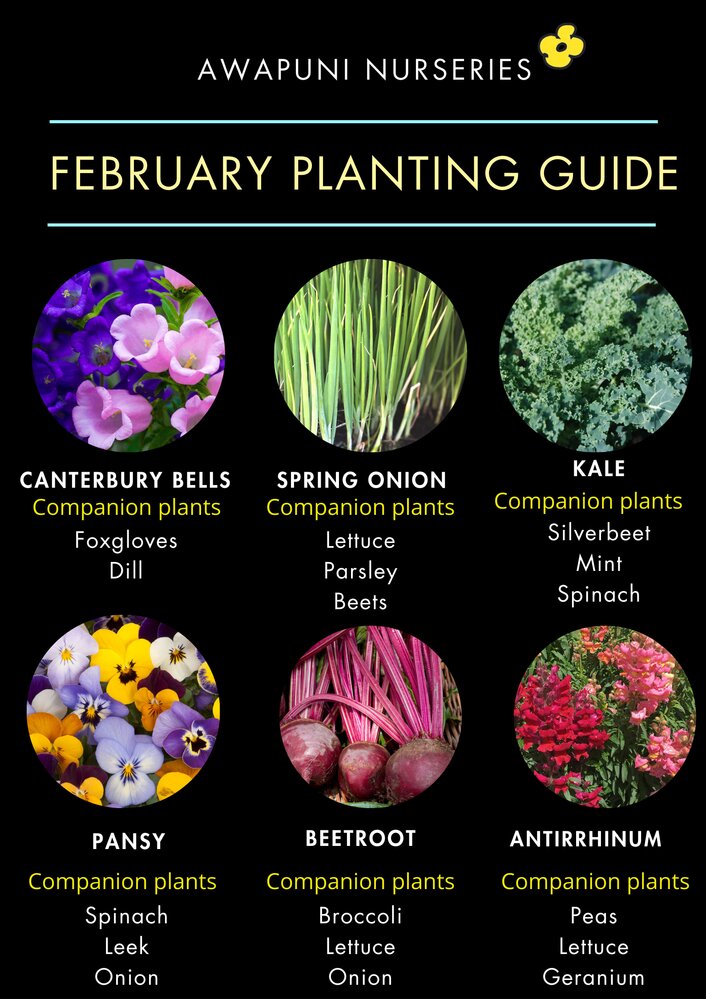There’s certainly been quite a lot of harvest recently! It’s satisfying to see very happy gardeners and their baskets full of fresh produce.
We enjoyed reading the questions, suggestions and interactions on how to preserve tomatoes, how to cook zucchini brownies, how to make plum sauce, how to protect passion fruit etc.
There’s more to come and much to prepare in the garden this month as we get ready for the colder season.
Tidy Up
-
Keep picking!
-
Keep on weeding and deadheading flowers.
-
Look around your garden and trim off tired-looking leaves on your veges and herbs.
Flower Garden
Mixing annual and perennial flowers in your garden helps invite beneficial insects.
It's a great time to plant canterbury bells, antirrhinums (commonly known as snapdragons or dragon flowers), violas and pansies. Awapuni Nurseries has over 20 varieties of beautiful pansies!
Edible Garden: Vege and herb
Still a lot of harvest to do! Keep on picking to encourage more fruiting. Chillies and cucumbers are pumping. Spend time trimming off leaves that are looking a bit dry and tired.
Consider staggering your planting - plant something new every few weeks starting now to prepare for the colder months.
It's a great time to plant:
Herbs - coriander, dill, basil and parsley.
Veges - brassicas (broccoli, cauliflower, cabbages, brussel sprouts, pak choy, kale, kohlrabi), carrots, spring onions
Grow more, Save more in Winter : Quick Tips for Continuous Crop
Vegetable gardening is a continuous process. Soil can get exhausted and could develop a build up of disease-causing pathogens. It's important to have a system for growing veges and group plants (vege & flowers) based on their characteristics.
Here are some tips for the coming winter growing season:
1. To ensure continuous supply of vegetables, gardeners need to switch from warm-weather plants to cool-weather crops. If you have multiple garden beds, an effective tip is to divide crops into respective planting areas. Plan beds in anticipation of the change in crops. Some gardeners have 4 beds (one for each vege family).
Here are some examples of veges grouped according to their vegetable families:
-
Alliaceae (Chives, Onions)
-
Cruciferae (Brassicas)
-
Cucurbitaceae (Cucumber, pumpkin, squash)
-
Legumes (peas, beans)
Cooler season veges are: brassicas (broccoli, cauliflower, broccolinis, spinach, endive, radicchio)
Warmer season veges are: beans, eggplants, tomatoes
All season options: lettuces, carrots, onions, herbs
If you have a smaller space, consider the following ideas for crop rotation: Instead of making 1 large, raised garden bed, consider having 3-4 smaller ones or consider using larger pots for plants that are more prone to diseases.
2. Crop rotation is useful to avoid or minimise the risk of diseases and pests.
When plants get diseases, the disease-causing elements (bacterial, fungal, viral diseases etc) stay in the soil for a while where the infected plants used to be.
If your area isn’t big enough for rotation planting, don’t plant anything in the garden for a year or two so disease-causing soil elements have nothing to feed on. Consider planting in containers temporarily to ensure vege supply.
3. Note that weeds also bring diseases, so it's important to keep the garden beds free of weeds.
4. Crop rotation helps manage soil fertility which gives plants more nutrients.
Peanuts are great in fixing nitrogen into the soil which improves soil fertility. They are usually followed by brassicas which are nitrogen-hungry.
Peas are good to plant before squash. Beans enrich the soil and a good crop to plant after tomatoes.
When the same veges are planted in the same spot year after year, the soil may no longer have the nutrients required by the plants.
5. As much as possible, always use a good quality garden / potting mix.
For more tips, check our gardening guides. View our planting calendar to see which plants are in season.
Happy Gardening!

